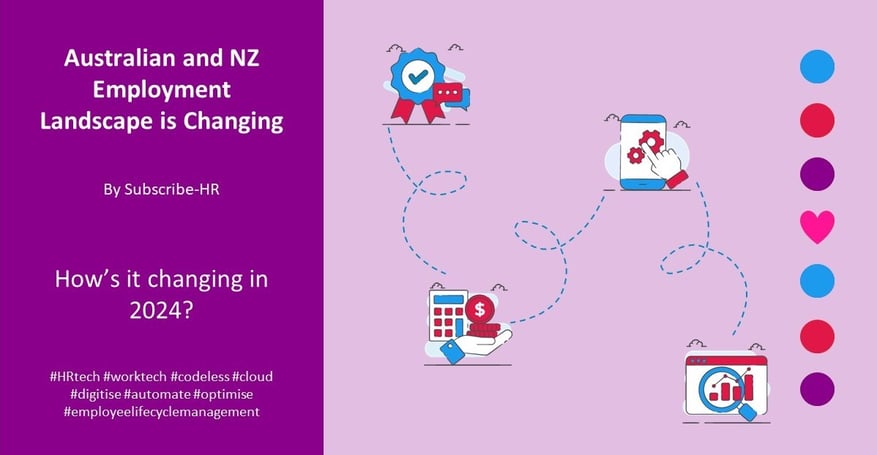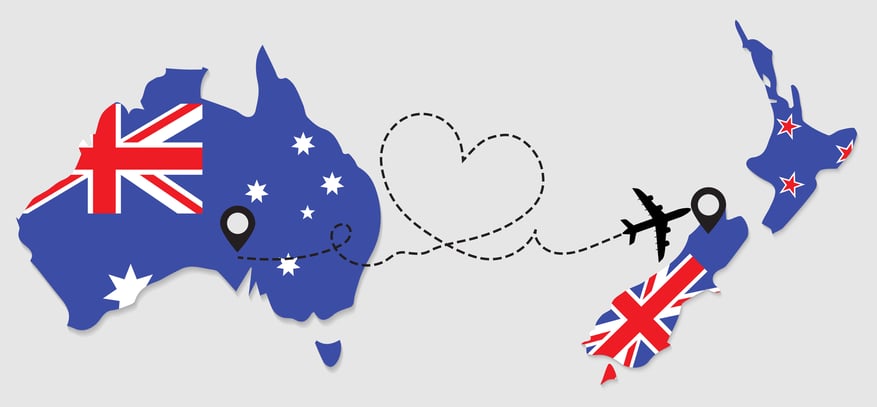As we step into 2024, the employment landscape in Australia and New Zealand is predicted to undergo a huge transformation. Talent acquisition, cost management, strategic workforce planning – us HR geeks expect a lot of changes this year.
In this blog post, we’ll be discussing all the challenges that lie ahead, and talking about some interesting strategies HR professionals can use to pave the way to success. Let’s dive right in!
Employment Challenges in 2024: AUS and NZ

Talent shortages
Persistent challenges in finding skilled employees
The relentless pursuit of skilled employees is still going strong this year. All sorts of different industries face the same challenge of a talent drought, where the demand for specialised skills consistently outpaces the available supply.
The impact on recruitment strategies and workforce planning
Faced with the ongoing competition for skilled professionals, organisations must prioritise their Employee Value Proposition (EVP) and showcase a real dedication to diversity, equity, and inclusion in order to attract and retain top-tier talent.
Organisations will need to go beyond immediate hiring needs and adopt a forward-thinking approach. This involves identifying the skills and competencies pivotal to future success and aligning workforce planning strategies accordingly.
Cost Consciousness
Shifting trends from unchecked spending to a more measured approach
Unchecked spending? Not anymore. The current economic climate means organisations have to be cost-conscious even down to HR.
In this era of controlling costs, companies find themselves in a delicate balancing act. The objective is to optimise operational efficiency and enhance productivity while managing costs judiciously.
Cost consciousness necessitates a strategic overhaul of traditional approaches. The emphasis is on prioritising intelligent investments that contribute to long-term financial resilience and sustainability.
Strategic Workforce Planning

The days of reactionary recruitment to emerging needs are over. To thrive and grow, organisations must embrace a forward-thinking approach, anticipating future talent requirements, and strategically aligning their workforce with long-term goals.
Importance of looking beyond immediate hiring needs
Strategic workforce planning is the alignment of an organisation's workforce with its strategic objectives. It goes beyond immediate hiring needs, involving forecasting future talent requirements and developing plans to hire and retain the right individuals. It's the strategic link between workforce planning and the overarching goals of a company.
Benefits of strategic workforce planning include ⬇️
Here are some benefits of anticipating talent needs:
- Improving organisational agility: Being responsive to changing market conditions and new opportunities
- Cost reduction: Mitigating expenses associated with reactive hiring, such as recruitment fees and training costs
- Enhancing employee engagement: Demonstrating value for employees' skills and talents
- Optimising organisational performance: Ensuring the right people are in the right positions at the right time
The impact of AI on job roles for long-term planning
Strategic workforce planning must now grapple with the evolving nature of job roles influenced by AI. It's not just about filling positions; it's about aligning human capital with technological advancements, ensuring a harmonious synergy that propels the organisation toward its goals.
This can look like:
- Developing a comprehensive inventory of AI-related skills within your workforce
- Identifying gaps and prioritising training programs to enhance AI literacy
- Leveraging AI-powered predictive analytics to forecast future talent needs
- Analysing historical data to identify patterns and trends for informed decision-making
- Evaluating existing job roles for tasks susceptible to automation using AI
- Redefining job descriptions based on the integration of AI technologies
- Implementing targeted reskilling and upskilling programs to prepare employees for AI-related roles
- Utilising AI tools for talent acquisition, such as automated resume screening and candidate matching
- Implementing AI-powered chatbots for streamlined onboarding processes
- Encouraging employees to embrace AI as a tool for professional development
- Prioritising diversity and inclusion in AI development and deployment
- Establishing ethical AI guidelines to mitigate biases and ensure fair decision-making
- Implementing AI-driven tools for comprehensive workforce analytics
- Developing a robust change management strategy to ease the transition to AI-integrated processes
Diversity and Inclusion (D&I)
This year, leaders face a pivotal moment to revamp their approach to Diversity, Equity, and Inclusion (DEI). This goes beyond a typical year-end checklist; it's a call to reshape our workplaces.
Nowadays changing socio-political landscape, accentuated by a high-stakes election, requires a nuanced, proactive DEI approach in 2024. The question is no longer 'why' but 'how' to strategically embed DEI principles for a more inclusive future.
Growing importance of genuine D&I strategies
It’s crucial that leaders start pivoting their approach to D&I ⬇️
- Review and align existing DEI programs: Before embarking on new initiatives, critically review existing DEI programs. Ensure they align with both employee needs and organisational goals. Leverage data to understand demographic trends within your organisation and gather feedback from employees at all levels.
- Operational data and employee voice: The combination of operational data and employee feedback provides a comprehensive view of the effectiveness of current initiatives. This dual approach allows for a clearer understanding of where adjustments are needed.
- Tailored investments over generic training: Despite substantial spending on unconscious and implicit bias training, tangible changes for historically underrepresented groups remain limited. Jeffery To, a researcher in experimental psychology, suggests a shift in focus from implicit biases to systemic changes. Prioritise sustainable initiatives, policy changes, equitable processes, and continuous learning and development programs over one-off training sessions.

Moving beyond lip service to create a diverse and inclusive workforce
Creating a diverse and inclusive workforce demands tangible actions that go beyond surface-level commitments. It involves fostering a culture where diversity is not just acknowledged but celebrated, and inclusion becomes an inherent part of organisational DNA.
Leaders need to translate words into meaningful initiatives, ensuring that diversity and inclusion are embedded in recruitment processes, professional development programs, and everyday workplace interactions. It's about actively dismantling barriers and championing equitable opportunities for all employees, regardless of their background.
In 2024, the call is for authenticity, for organisations to not just speak diversity and inclusion but to live it in every facet of their operations. This approach not only fosters a harmonious work environment but also cultivates innovation, creativity, and resilience — a testament to the true power of diversity and inclusion in shaping the future of work.
Remote Workforce Model
As the world grapples with the ongoing debate of returning to the office, the tug-of-war between employee preferences and employer demands persists. The dichotomy between the perceived benefits of in-office collaboration and the newfound appreciation for remote work continues to shape workplace dynamics.
Adapting to the remote work trend accelerated by the pandemic
The year 2024 witnesses a noticeable push by major corporations to bring employees back to the office, challenging the remote-friendly culture established during the pandemic.
Despite the resistance from employees who value remote flexibility, CEOs aim to regain control, leading to a palpable tension in workplace expectations. The clash between a return to the traditional office setting and the growing desire for flexibility reflects a seismic shift in how work is perceived and executed.
Addressing challenges and opportunities in a distributed workforce
The evolving workplace landscape demands a nuanced approach, and the concept of a rigid five-day office week is fading. In 2024, workplace experts predict a surge in organisations adopting hybrid work models. This approach allows employees to experience the best of both worlds — blending in-office collaboration with the freedom of remote work.
While remote work brings advantages like flexibility and improved work-life balance, it is not without challenges. Feelings of isolation and a lack of social interaction can hinder the sense of community among remote employees. Striking the right balance between remote and in-office work is crucial to harness the benefits of both.
How can organisations efficiently choose their model?
Choosing between remote, hybrid, and office-only work models involves evaluating their respective pros and cons. Remote work offers autonomy and flexibility but may lead to isolation. Hybrid models provide a middle ground, combining flexibility with in-person collaboration, but necessitate clear guidelines.
Office-only work fosters immediate collaboration and community building but may limit flexibility. Companies must navigate these nuances and align their chosen model with the unique needs and objectives of their workforce.
As the workplace evolves, the conversation goes beyond the return to office or the merits of remote work. It's about creating a harmonious environment where diversity is celebrated, equity is pursued, and inclusion becomes the norm. In 2024, the journey involves not just adapting to change but actively shaping the future of work.

Employment Opportunities in 2024: AUS and NZ
A lot of opportunities are emerging this year for AUS and NZ organisations – the dynamics of work are evolving, unfolding avenues for innovation, talent retention, and skill development. 👇
Internal Mobility: a Powerful Tool for Talent Retention
Internal mobility involves the internal movement of employees within an organisation for career transitions or development. This dynamic approach can manifest as an upward shift to a position with heightened responsibilities, a lateral move to an equivalent position, or even a geographical relocation.
➡️ The primary goal? Talent retention and the enhancement of employee engagement within the company.
Recruitment is a costly affair, and tapping into internal talent can be an economic boon. The expenses tied to external recruitment, including processes, levels, and locations, are mitigated when sourcing talent internally. Familiarity with HR processes and reduced candidate search costs add to the allure.
Additionally, employee satisfaction and internal mobility share a symbiotic relationship. Contented employees are more likely to explore job changes within the company. To unlock this virtuous cycle, regular measurement of employee satisfaction becomes paramount. By creating avenues for professional growth and fulfilment, organisations can organically channel this satisfaction towards embracing internal mobility. 🙌
Leveraging internal mobility to retain valuable skills
Retaining valuable skills within an organisation is becoming more crucial than ever. Leveraging internal mobility emerges as a strategic approach to achieve this goal.
When they facilitate the movement of employees within the company for career transitions or development, organisations can retain the wealth of skills and knowledge already embedded in their workforce. This not only serves as a cost-effective alternative to external recruitment but also cultivates a culture where employees feel valued and supported in their professional growth.
Through internal mobility, companies can tap into the diverse expertise of their existing talent pool, ensuring that vital skills stay in-house and contribute to the organisation's resilience and adaptability.
Immersive Learning

Nowadays, traditional training methods struggle to meet the demands of a remote and hybrid work environment. Enter immersive learning solutions, equipped with extended reality, the metaverse, and artificial intelligence.
These transformative tools are reshaping education, offering experiential courses that enhance knowledge retention, reduce risk, and provide actionable insights. ⬇️
More knowledge retention and recall
Immersive learning solutions bring a new dimension to training by providing hands-on experience in realistic, simulated environments. Whether it's interacting with AI avatars or navigating virtual scenarios, learners don't just grasp theory; they put it into practice. The activation of multiple senses and emotional engagement further enhances memory retention, making immersive learning a powerful tool for training and development.
Reducing risk
Certain skills demand hands-on experience, but exposing individuals to risky situations for training is impractical. Immersive learning solutions, leveraging AR, VR, MR, and the metaverse, allow individuals to navigate hazardous environments safely.
From medical professionals practising surgeries on virtual patients to industrial workers mastering heavy machinery operation, immersive learning mitigates risks associated with real-world training scenarios. Firefighters and police officers can also hone their skills in life-threatening situations without actual peril, contributing to a safer and more effective training environment.
Better insights and analytics
Immersive technology not only facilitates learning but also offers rich insights into the educational journey. Unlike traditional training tools, extended reality captures comprehensive data, showcasing correlations between user interactions and information consumption. Metrics such as heart rate and eye movements provide valuable feedback on emotional responses to content.
This wealth of information enables the creation of more impactful educational content, leading to accelerated knowledge transfer and enhanced retention. Instructors can utilise these insights to tailor immersive learning experiences for increased engagement.
Keeping learners focused
Traditional learning environments are rife with distractions, making it challenging for learners to stay focused. Immersive learning eliminates these distractions by placing learners at the centre of the experience. VR, in particular, immerses students in a world free from external interruptions, resulting in improved focus. The excitement and interactivity of immersive experiences also contribute to higher completion rates, making learning more engaging and enjoyable for participants.
More accessibility and participation
Delivering consistent learning experiences to a diverse workforce, especially in remote or hybrid settings, poses a significant challenge. Immersive learning solutions offer a solution by ensuring uniform access to powerful learning experiences. VR experiences and AR apps can be shared globally via the cloud, enabling every employee, regardless of location, to benefit from the same immersive training.
Customisation options further enhance accessibility, accommodating the unique needs of each learner. The excitement and interactivity of immersive learning foster higher participation rates, creating an environment where employees are actively invested in their education.
Microlearning: Breaking Down Complex Topics into Bite-sized Pieces

The average attention span has dropped by nearly a third in just under two decades, a trend attributed to the prevalence of short-form video platforms like TikTok. However, these platforms offer valuable insights into engagement strategies. Micro learning, characterised by bite-sized, relevant content, emerges as the solution for today's busy workforce battling digital fatigue and competing demands.
The versatility of micro learning is evident as it finds application in compliance, role-specific, regulatory, and upskilling training courses. Its impact extends beyond time efficiency; micro learning enhances the learner experience and promotes more effective outcomes. Udemy's survey reveals that 61% of corporate L&D experts prioritise closing the skills gap, emphasising the need for time-efficient, cost-effective, and impactful learning opportunities.
Adapting to shorter attention spans with microlearning
Micro learning not only reduces the time spent on training activities but also proves more useful for learners in the short and long term. Research indicates that microlearning improves focus and supports long-term retention by up to 80%. By breaking down content into easily digestible modules, micro learning keeps learners engaged and helps them retain information effectively, making core essentials readily accessible.
Employment Changes in 2024: AUS and NZ
Along with challenges and opportunities for AUS and NZ organisations this year, we’re seeing some interesting changes come to light. Let’s explore 👇

The Impact of Generation Z in 2023
Gen Z's influence on rejecting "hustle culture"
Generation Z, born roughly between the mid-1990s and early 2010s, is making a significant impact on workplace dynamics, particularly in their rejection of the pervasive "hustle culture." Unlike their predecessors, Gen Z places a premium on holistic well-being over the glorification of overwork. In 2023, this rejection reverberated across industries, challenging traditional norms that equate success with relentless hustle.
The ethos of balance and sustainability prevails among Gen Z, leading to a reevaluation of workplace expectations. The outdated belief that longer hours equate to higher productivity is giving way to a more nuanced understanding of efficiency and the importance of maintaining a healthy work-life equilibrium.
Emphasis on work-life balance and the introduction of new work trends
A cornerstone of Gen Z's impact is the emphasis on work-life balance. The insistence on a healthier integration of work into life has prompted organisations to rethink their structures and policies. Flexibility, once viewed as a perk, is becoming a non-negotiable expectation.
In response to these shifting priorities, companies in Australia and New Zealand are introducing innovative work trends. Remote work, once a contingency measure, is evolving into a permanent feature, fostering a hybrid model that combines the benefits of both in-person and remote collaboration. This evolution is driven not just by external factors but by a genuine acknowledgment of the diverse needs and preferences of the workforce, particularly the incoming Gen Z professionals.
Employment changes in 2024 are marked by a departure from the rigid structures of the past. The landscape is adapting to accommodate the aspirations of a generation that values experiences, meaningful contributions, and a workplace culture that aligns with their principles.

Future Workforce Composition
The tech-savvy and digitally connected environment they bring
By the year 2025, Gen Z and Millenials will have become the majority force, reshaping the dynamics of workplaces across industries.
Having grown up in an era defined by rapid technological advancements, these generations inherently possess a fluency with digital tools and an intuitive understanding of the interconnected landscape of the internet.
This digital acumen serves as a catalyst for innovation and efficiency in the workplace. Gen Z and Millennials are predisposed to embrace emerging technologies, fostering an environment where digital transformation is not just a corporate initiative but a collective mindset ingrained in the workforce.
The influx of Gen Z and Millennials into the majority of the workforce brings about a reimagining of work environments. The traditional hierarchical structures are giving way to more collaborative, agile, and tech-driven spaces. These generations place a premium on flexibility, meaningful work, and a sense of purpose in their professional endeavours.
Moreover, the reliance on digital communication tools, remote collaboration platforms, and cloud-based technologies becomes second nature. The workplace of 2025 will witness an evolution where the integration of technology is seamless, fostering an environment that nurtures creativity, adaptability, and continuous learning.
Changing Workplace Dynamics
Workplace dynamics in 2024 will be marked by a shift towards values-driven, innovative, and flexible paradigms. The changing dynamics are driven by a confluence of factors, including a heightened focus on diversity, sustainability, and social responsibility. 👇
Focus on diversity, sustainability, and social responsibility
Organisations are recognizing the inherent value of diverse perspectives, experiences, and backgrounds. This emphasis on diversity extends beyond gender and ethnicity to encompass a broader spectrum, including neurodiversity, socioeconomic backgrounds, and more. A diverse workforce not only fosters creativity but also aligns with the growing societal emphasis on inclusivity and equality.
Sustainability and social responsibility have emerged as guiding principles for businesses. Workplaces are increasingly conscious of their environmental impact, adopting eco-friendly practices, and integrating social responsibility into their core values. This conscientious approach is not only a response to global challenges but also a reflection of the values held by the emerging workforce.
The demand for innovations and flexible work arrangements
In the quest for competitiveness and relevance, workplaces are experiencing an increased demand for innovation. This goes beyond technological advancements and extends to innovative approaches in problem-solving, collaboration, and product/service development. Organisations fostering a culture of continuous innovation are better positioned to adapt to the dynamic needs of the market.
Flexibility has become a non-negotiable aspect of the contemporary workplace. The traditional 9-5 work model is gradually giving way to more flexible arrangements that prioritise outcomes over rigid schedules. The ability to work remotely, adopt flexible hours, and leverage technology for virtual collaboration has become central to attracting and retaining top talent.
Introduction of "microshifts" for personalised work arrangements
A notable trend in changing workplace dynamics is the introduction of "microshifts." This innovative approach recognizes that a one-size-fits-all model for work hours is outdated. Instead, organisations are moving towards personalised work arrangements tailored to individual preferences and peak productivity times. The concept of "microshifts" allows employees to align their work schedules with their natural energy levels, promoting better work-life balance and overall well-being.

Takeaway
As we approach 2024 and beyond, it is clear that the traditional notions of work are making way for a more diverse, sustainable, and socially responsible environment.
The integration of innovative technologies, emphasis on flexibility, and the rise of personalised work arrangements showcase a workforce that is not just adapting to change but actively shaping it.
Organisations that embrace these shifts will not only attract top talent but will also position themselves as pioneers in fostering inclusive, forward-thinking, and adaptable workplaces. The future work terrain beckons, inviting us to navigate with agility, openness, and a commitment to the principles that define the modern era of work.

